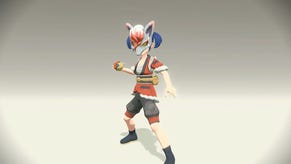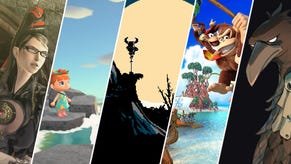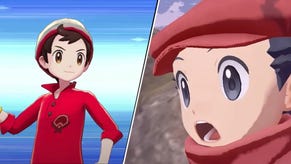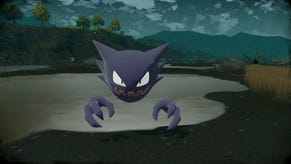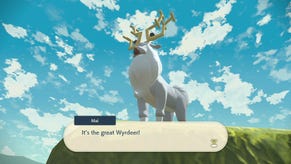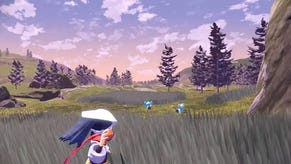Pokemon Legends: Arceus review – the best Pokemon in 20 years
Minor issues with the technical presentation and pacing be damned, Pokemon Legends: Arceus is the best Pokemon adventure in 20 years.
Back at the turn of the millenium, I had a dream. The Nintendo GameCube was about to release, and I was utterly Pokemon obsessed. Pokemon RBY and GSC remain some of my favorite games of all time – but I was also a Final Fantasy fan. I’d spent those same years being wowed by the scale and spectacle of the PS1’s Japanese RPG catalogue, and as a Pokemon fan I couldn’t help but wonder: what if Pokemon was like this? I’d play that GameCube tech demo over 56k internet over and over again and while the Zelda bit was my favourite, a brief glimpse of Pokemon dancing had set my mind racing. What if Pokemon was 3D, and as ambitious in scope as the other world-shaking console JRPGs?
That dream never really came true, of course. While I absolutely see the quality in later generations, I think it’s fair to say that Pokemon stagnated. It gently iterated on the formula of past games, and even when it was time to make the jump to 3D, it played it surprisingly safe. The last all-new entry, 2019’s Sword and Shield, took baby steps towards truly shaking things up. But now, 20 years later, the dream feels like it is reality in Pokemon Legends: Arceus.
Think of things you know about Pokemon. Series staples. There is every chance it is gone. Pokemon automatically changing forms when they hit certain requirements? Gone; it’s now an opt-in process, where you evolve Pokemon through the menu once you’re ready. Random encounters? Gone, replaced with Pokemon out on the overworld. Gym Battles? Gone; they don’t yet exist in this ancient version of the Poke-world. Learning moves via TMs and deleting old moves forever to make room for new ones? Gone, gone, gone. Even the very concept of a ‘Pokemon Trainer’ doesn’t exist in this game, as the world it’s set in is one before any of those systems and concepts of the Pokemon lore came to exist.
Reflecting on Legends: Arceus after finishing the core game, around eighty percent of the side-quests, and all but one of the post-game tasks, I wonder what came about first. Was it the desire to set a game here, in the ancient past of the Pokemon world? Was it a curiosity to attempt to mimic the earth-shattering success of Breath of the Wild? Was Game Freak bored, at last, of building games from the same template? Whatever the answer, I’m incredibly glad it happened; this is the best Pokemon in years.
When thinking about this game, it’s probably best to leave any preconceptions of the Pokemon series at the door. Reading forums this last week, for instance, I’ve seen people talking about their planned team – but that’s a moot point. In this game, your best way to complete key objectives is to change your team up, often. As such, it no longer makes sense to have a team of specific Pokemon you love and only use them (at least for much of the game). Subtle changes to the systems and concepts of Pokemon weave through the game to make many traditions obsolete – and these tweaks and overhauls add up to create something incredibly fresh.
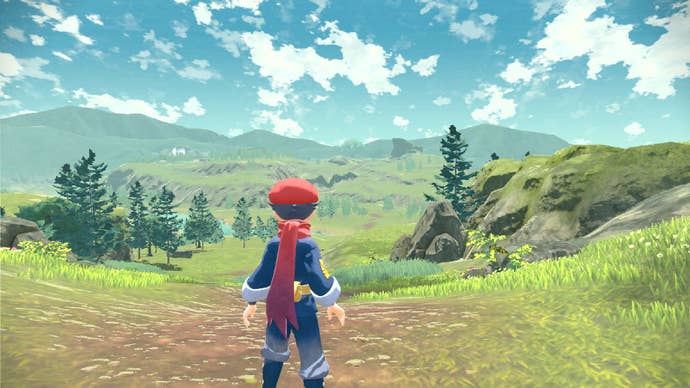
Let me explain that last example. In Pokemon Legends: Arceus, one of your goals is to complete the very first Pokedex of the Hisui region, which in the far future will become Sinnoh, the setting of Pokemon Diamond and Pearl. But because the Pokedex and associated research doesn’t exist at this point in history, simply catching a Pokemon isn’t enough to create their scientific encyclopedia entry. You have to research them. You do that by completing a range of tasks, which are slightly different for each species. You might level up a Pokemon’s research level by seeing it perform certain moves, by catching or defeating more of them, or subduing powerful ‘Alpha’ variants of them, for instance. As such, it’s often beneficial to swap out the Pokemon on your team regularly to help contribute towards research. I ended up picking three team ‘staples’, then swapping around the other three slots in my team regularly for research purposes right through to the end-game.
The focus on filling out the Pokedex then trickles down to other systems. In traditional games, the act of catching ‘em all involves – simply – catching one of each creature. Here, in Hisui, you’ll usually need to catch multiple for your research. Luckily, the process of catching is itself streamlined. Out in the world, you can crouch in tall grass or distract a Pokemon with an item and then toss a PokeBall to catch them without ever entering a battle encounter. Some Pokemon might run away, but others are aggressive, and you now have the option to dodge their attacks with a roll, running and hiding out-of-sight instead of immediately entering battle.
As I got comfortable, I found myself tossing two or three balls at once, catching several weaker Pokemon in the space of seconds. You even get EXP for this, which lowers the grind barrier significantly. I also got good at dodging the attacks of powerful Pokemon as a lone trainer. Of course, the traditional method of catching – battling to weaken, then toss a ball – still works, and is practically required for more powerful beasts. But even the age-old Pokemon staple of combat has been significantly reconsidered for this game.
There’s quite a bit different in battle. Some changes are cool but inconsequential, like being able to move your trainer around in the middle of a skirmish. That’s a change that accomplishes nothing, as position is irrelevant, but it does make combat feel more dynamic and involved, at least. This is the first Pokemon game in forever where I haven’t eventually switched off battle animations. Other changes are of more substance, however – the largest being the ability to perform moves in an ‘Agile’ or ‘Strong’ style, in addition to the normal.

I absolutely love this addition to the Pokemon meta. Agile moves come out faster but are weaker, while Strong moves are of course the opposite. Normal moves, your standard, sit in the middle. Rather than a hard back-and-forth turn order, you can now use speed as a strategy and maneuver yourself into situations where you can do more than one move in a row, or sacrifice a turn to get in an extra-heavy hit. There’s even a turn-order display you can check to see the next six turns ahead, and see when you’ll be attacking. It’s brilliant, and channels some real triumphs of the non-active turn-based RPG world, like Final Fantasy 10.
So despite not being shown much pre-launch, Pokemon battling is absolutely a core component of this game. You’ll mostly be fighting wild Pokemon, as the competitive battling league doesn’t yet exist at this point in the Poke-timeline – but there are still battles against other human characters regularly. In a curious twist, both in the wild and against trainers, multi-Pokemon fights are fairly common. You only ever deploy one, but it’s not unusual to end up facing down two or three Pokemon at once. Again, the rules and etiquette of battle don’t yet exist, so a rival or enemy might choose to send out two or three Pokemon at once. It’s a new frontier out there.
These battles occur across a large land that isn’t quite as much of an open world as some of the pre-launch chatter suggested. For Pokemon fans, the easiest point of comparison is actually Pokemon Snap, of all things. You have one central hub, Jubilife Village, and from there can head out to adventure in five different regions which all have a broad biome and theme: fields and forests, marshland, the coast and a volcano, icy mountains, and harsh rocky peaks.
The structure is more like Monster Hunter than anything else. The loop of heading to an area, catching and battling to gather research, then returning to town to report your findings to the professor and do some upgrades and crafting feels particularly reminiscent of Capcom’s keystone series. The crafting system, by the way, is rudimentary but decent: you gather resources in the world and can craft anything from PokeBalls to lures and healing items from the menu at any time. Crafting recipes are unlocked as you progress, or can be purchased or earned through side content. This is the most ‘proper’ RPG Pokemon has ever been, so there’s a proper quest log with the better part of 100 different side quests to tackle – most of which tie directly into resource gathering or research tasks.

I’d stop short of saying Legends: Arceus takes the best of games like Breath of the Wild and Monster Hunter, but it certainly takes some good cues. Sometimes I feel like classic Pokemon design undermines these new elements a tad; this is the least hand-holdy Pokemon in years, but NPCs still automatically drag you to the next story moment if you talk to or get too close to them while exploring the open world. Generally speaking, however, there’s not much I don’t love about the changes; the balance between old and new has been expertly struck.
The essence of Pokemon is intact, but the game is ultimately a completely different experience to every other Pokemon game. People have been comparing Legends: Arceus to Zelda: Breath of the Wild from the minute it was announced, because in a trailer their open worlds look similar. In practice, they don’t have that much in common, except for where the games stand in the wider pantheon of their esteemed series’. BOTW was a revelation of new ideas after Zelda had essentially dined out on the formula established by Ocarina of Time, which itself was a 3D retread of Link to the Past, for almost two decades. Pokemon Legends: Arceus is the same, breaking from the thesis set out in the original games while holding tightly to what makes Pokemon… well, Pokemon.
One thing maintained, unfortunately, is Game Freak’s technical abilities. Legends: Arceus is better looking than Sword and Shield, and certainly larger in scope, but it’s also undoubtedly a little bit all over the place technically. Sometimes it catches you with striking beauty, the game’s art style and watercolor-like world palette working well to hide technical deficiencies. But then pop-in brings you right back to earth. Clever directorial decisions, like how when you dash on a mounted Pokemon the camera gently tries to tilt towards the mountain at the center of the world, make things feel majestic. But then you’re dropped into an intense set-piece encounter with a massive Pokemon and can enjoy the frame rate sliding into the teens as the screen fills with a flurry of particle effects that would look impressive, if not for the combined slowdown and resolution drop. You glide through the air and view the world at a distance, and it’s really quite pretty if you ignore the pop-in… but then you land and the water is terrible and some of the textures are two-generations-gone stuff. It’s a pain, and having seen what has been accomplished with BOTW, I darkly expect emulation buffs will be all over this one.
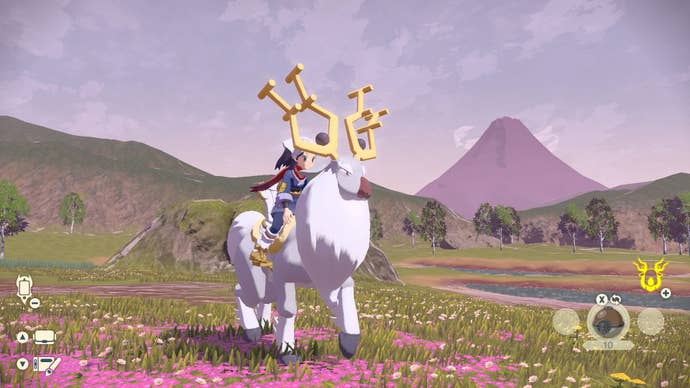
Of course, I get it to some degree. The Pokemon Company and Game Freak are backed into a corner. If we compare this to Zelda, for instance, BOTW reuses the same enemy character models, recolored, with lots of reused animation. There's maybe 25 unique types of enemy in that game, including bosses. There's a couple hundred Pokemon in this game; that's a lot of model and animation work. Because of this, I understand Pokemon battles are never gonna look like Final Fantasy. But why is this world so wildly uneven? What the hell is going on with some of this texture work? Why is the performance so all over the place? This is one of the biggest video game franchises in the world; they should be able to do better.
While we’re addressing complaints, I think the pacing is a little off, too. Side quests arrive in a drip-feed that feels slightly unoptimized, and the story has a few moments where it falls rather flat. Some characters are cool, and I found myself wanting to know more about them, but then end up barely utilized. I was also frustrated by the final stages of the game. No spoilers here, but to keep it vague: the credits roll as a bit of an anti-climax, and then a bunch of stuff that’s in the ‘post-game’ feels like it should’ve been the other side of the credits, but was excised from the main game in order to buff out the post-credits experience. Which is a shame, also, because that segment is one of the most thrilling in the game, and a great pay-off to the abilities, inventory, and Pokemon you’ve obtained up until that point.
The thing about video games, though, is they don’t necessarily need those technical aspects to be on-point to be great. Pokemon Legends: Arceus is a perfect example of that. The stuff it doesn’t get right pales in comparison to the stuff it does. Or to put it another way: I’ve reviewed every major Pokemon game since the 3DS era, but this is the first where the process of playing such a dense game in such intense sessions to get you a review on time hasn’t remotely burned me out. The binge came easy this time.
Far too much of what it was doing differently was hidden pre-release. Pokemon Legends: Arceus threads the needle and somehow finds a brilliant balance between old and new, between tradition and upheaval. It’s the 3D Pokemon adventure that I imagined back in the 90s that never came. It’s fresh. It feels new, exciting, and like a powerful new beginning for the series. Technical shortcomings and minor frustrations can’t take away what this game achieves elsewhere; it’s the best main-series Pokemon game in a long, long time.




